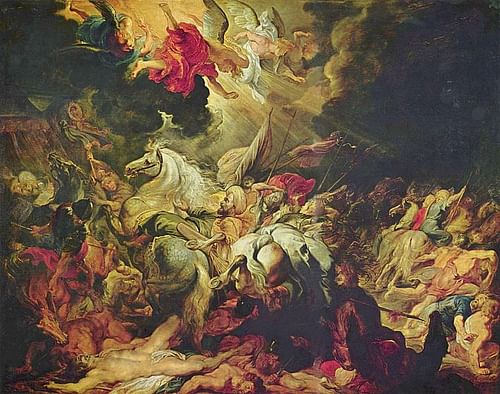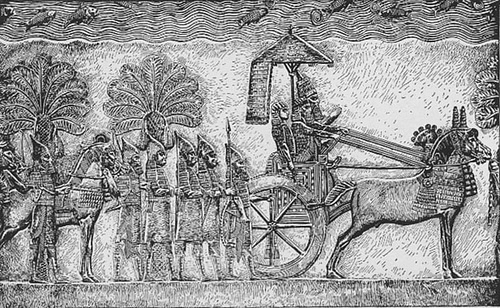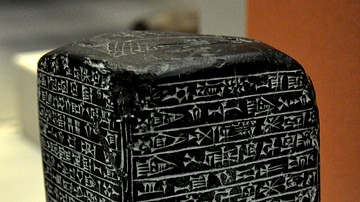The reign of Assyrian king Sennacherib (705-681 BCE) was chiefly characterized by his difficulties with Babylon. Throughout the history of the Assyrian Empire, Babylon had caused problems and had even been destroyed by the Assyrian king Tukulti-Ninurta I in c. 1225 BCE. Even so, there were direct cultural bonds between Babylon and Ashur, capital of the Assyrian Empire, and the city was always re-built and re-populated. Babylon was more than just a physical city of bricks and streets in the minds of the Mesopotamians: it was a cultural center of immense significance. Tukulti-Ninurta I's desecration of Babylon and her gods, in fact, led directly to his assassination. Owing to its status among the people of Mesopotamia, however, the people of Babylon seemed to feel that they could repeatedly throw off the authority of whatever ruling body held the region with impunity, and one can understand how a king could become tired of such an attitude. This was precisely what happened with Sennacherib in his dealings with the great city.
Sargon II & Sennacherib
Sennacherib's problems with Babylon were largely inherited. His father, Sargon II (reigned 722-705 BCE) had defeated the tribal chieftain Merodach-Baladan and driven him from Babylon but had allowed him to live. Once Sargon II was dead, and Sennacherib took the throne, Merodach-Baladan returned to Babylon and re-claimed the throne. The Babylonians welcomed him; Sennacherib had done nothing at all to endear himself to the city. As the new king, he was supposed to have participated in the ceremony in which he took the hand of the statue of the god Marduk as a sign of respect for the god, Babylon, and the people Marduk presided over. Instead, Sennacherib had simply sent them word that he was now king of Babylon and never even bothered to visit the city. Merodach-Baladan was not in the least bit concerned about the new king. Sennacherib was considered a weakling. He had never taken part in any of his father's military campaigns and had spent his earlier life as crown prince with administrative duties, while Sargon II had achieved his glorious victories on the battlefield. When Sennacherib heard that Merodach-Baladan had taken Babylon, he did not even lead a force to re-claim it himself but, instead, sent his commander-in-chief at the head of an army. This force was swiftly defeated by the combined forces of Babylon and their allies the Elamites and Aramaeans in 703 BCE. Babylon then arranged its troops, just in case the Assyrians came back again, and settled down to its own business. According to the historian Susan Wise Bauer:
That was the last straw. Sennacherib himself came sweeping down like the wrath of Assur and broke through the allied front line, barely pausing. Merodach-Baladan ran from the battlefield and crept into the marshes of the Sealand, which he knew well, to hide himself; Sennacherib marched the rest of the way to Babylon, which prudently opened its gates as soon as it saw the Assyrian king on the horizon. Sennacherib came through the open gate, but chose to send Babylon a message: he ransacked the city, took almost a quarter of a million captives, and destroyed the fields and groves of anyone who had joined the alliance against him (384).
The people of Babylon quickly realized that the poor opinion they had held of Sennacherib was misguided. In this early campaign the new king showed himself an adept tactician, able military leader, and ruthless enemy.
Sennacherib Bides his Time
Although he sacked the city, he did not destroy it. Merodach-Baladan escaped following the battle and fled to safety in Elam where he would instigate further trouble for the Assyrians. After taking Babylon, Sennacherib placed a trusted official named Bel-ibni on the throne to rule for him. Bel-ibni had been raised alongside Sennacherib in the Assyrian court and was thought to be trustworthy. It turned out that, however loyal Bel-ibni may have been, he was an incompetent ruler who, over time, began to allow the southern regions to do as they pleased. Some years later, around 700 BCE, Merodach-Baladan returned from hiding and again incited rebellion in region. Sennacherib marched south again to put down the revolts. He sent Bel-ibni back to Nineveh and appointed his favorite son and chosen heir, Ashur-nadin-shumi, to rule Babylon. In 698 BCE Ashur-nadin-shumi was kidnapped by the Elamites who then claimed Babylon as their own. Sennacherib marched on the city, defeated the Babylonians, and executed the rebels, but there was no word on the fate of his son and no ransom had been demanded for his return. This action “produced a full-blown war between Assyria, Babylon, and Elam. Fighting went on for four years” (Bauer, 388). Sennacherib mounted an enormous expedition to invade Elam that included Phoenician ships and the whole might of the Assyrian army. The Assyrians lost the war, and Ashur-nadin-shumi was presumed dead (scholars in the present day believe he was executed sometime around 694 BCE). Sennacherib returned to his capital at Nineveh and occupied himself with building projects for the next five years. He seemed to have forgotten about Babylon but, actually, was only biding his time.
Sennacherib Strikes
In 689 BCE the Elamite king died, and Sennacherib struck quickly at Babylon. The city fell, and he sent the pretender to the throne back to Nineveh in chains. He had spent more time during his reign dealing with Babylon and the Elamites, and had expended more men and resources on dealing with the city, than on any other campaign. His patience had run out, and so he ordered the city to be razed to the ground. His inscription reads, in part:
I swiftly marched to Babylon which I was intent upon conquering. I blew like the onrush of a hurricane and enveloped the city like a fog. I completely surrounded it and captured it by breaching and scaling the walls. I did not spare his mighty warriors, young or old, but filled the city square with their corpses...I turned over to my men to keep the property of that city, silver, gold, gems, all the moveable goods. My men took hold of the statues of the gods in the city and smashed them. They took possession of the property of the gods. The statues of Adad and Shala, gods of the city Ekallati that Marduk-nadin-ahe, king of Babylonia, had taken to Babylon at the time of Tiglath Pileser I, King of Assyria, I brought out of Babylon after four hundred and eighteen years. I returned them to the city of Ekallati. The city and houses I completely destroyed from foundations to roof and set fire to them. I tore down both inner and outer city walls, temples, temple-towers made of brick and clay - as many as there were - and threw everything into the Arahtu canal. I dug a ditch inside the city and thereby levelled off the earth on its site with water. I destroyed even the outline of its foundations. I flattened it more than any flood could have done. In order that the site of that city and its temples would never be remembered, I devastated it with water so that it became a mere meadow (Nagle, 26).
Babylon was destroyed and the statue of their god, Marduk, was carried back to Nineveh as a war trophy. Sennacherib no longer had to worry about who was ruling in Babylon or what trouble they might cause because the city no longer existed. He may have thought that now Babylon could cause him no further problems but, if so, he was mistaken. As in the reign of Tukulti-Ninurta I, the people were outraged at Sennacherib's destruction of the great city and, further, by his sacrilege in plundering the temples and taking the statue of Marduk as a prize. Bauer writes, “Turning Babylon into a lake – covering the civilized land with water, returning the city of Marduk to the primordial chaos – was an insult to the god. Sennacherib compounded this by ordering the statue of Marduk hauled back to Assyria” (389). The Assyrians and Babylonians revered many of the same gods – even though they often had different names – and this insult to Marduk, the god who had brought order out of chaos, was intolerable.
The Death of Sennacherib
The Book of II Kings 19:37 states, “One day, while [Sennacherib] was worshiping in the temple of his god Nisrok, his sons Adrammelek and Sharezer killed him with the sword, and they escaped to the land of Ararat. And Esarhaddon his son succeeded him as king.” Assyrian inscriptions also maintain that he was killed by his sons but differ on whether he was stabbed or crushed to death. The historian Stephen Bertman writes, “Sennacherib was stabbed to death by an assassin (possibly one of his sons) or, according to another account, was crushed to death by the monumental weight of a winged bull that he just happened to be standing beneath” (102). However he was killed, it is thought that he was assassinated because of his destruction of the city of Babylon.







